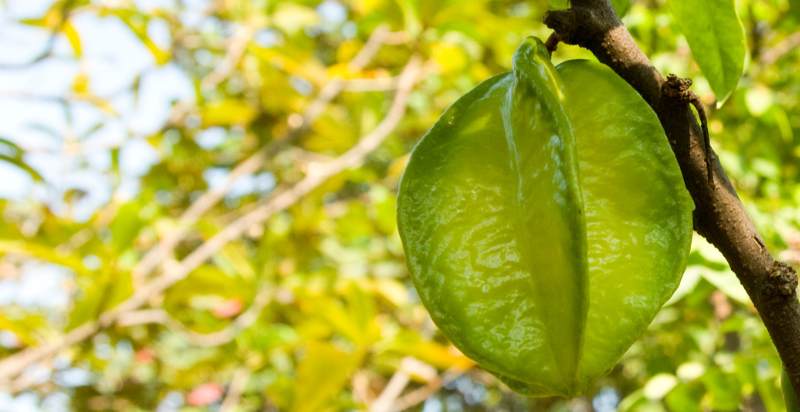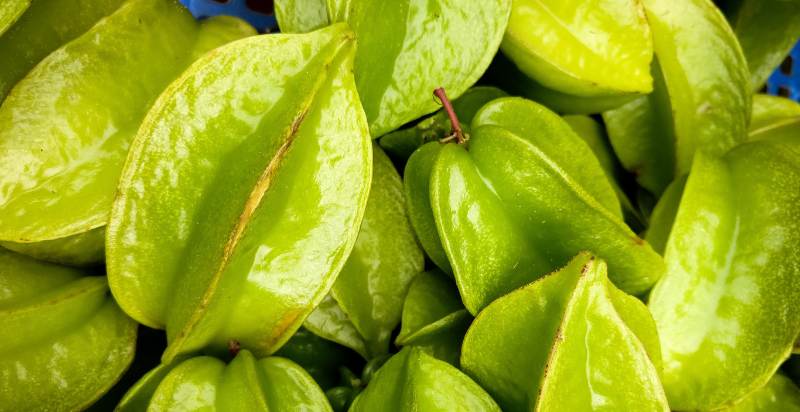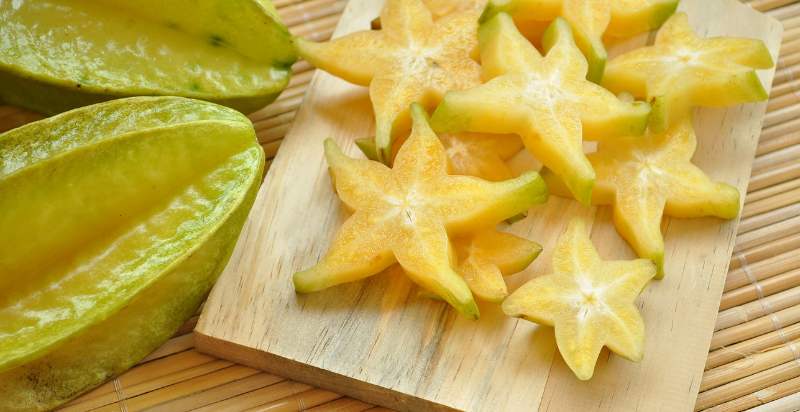Starfruit, also known as carambola, is a tropical fruit native to Southeast Asia and India. The star-shaped fruits are crunchy, sweet, and juicy with a slight tartness. They can be eaten raw or used in cooking. Starfruit has numerous health benefits, including boosting immunity, aiding digestion, improving eye health, reducing inflammation, protecting against cancer, and more. Here’s everything you need to know about this incredible fruit.
What is Star Fruit?
Starfruit, or carambola, is a tropical fruit that belongs to the Averrhoa family. It grows on trees that may reach up to 30 feet in height and produce 5–15 cm long fruits. Its skin is yellow-green with light brown ridges, while its flesh is white or yellowish-white with tiny edible seeds. When cut crosswise, it resembles a star shape hence its name — starfruit.
History and Origin of Star Fruit
Starfruit was first documented during the 6th century in Sri Lanka and is still widely consumed today. By the 16th century, Starfruit had spread throughout the region, becoming a favorite local snack because of its sweet and sour taste.
The popular fruit, which gets its name from the star-shaped cross-section when it is cut in half, was introduced to the Western world by Portuguese traders in the late 1500s. From there, it spread across the Caribbean Islands and North and South America. It eventually made its way to Australia and Hawaii, becoming a popular local delicacy today.
Starfruit’s popularity is undoubtedly due to its unique flavor profile; when ripe, Starfruit has a balance of sweet and tart flavors that make it perfect for use in both savory dishes or as a refreshing snack on its own. It also contains numerous nutrients such as vitamins A, C, B6, and potassium, as well as dietary fiber and antioxidants.
Starfruit is widely available in many parts of the world, including Europe, North America, South America, Australia, and Southeast Asia. It can be enjoyed fresh or cooked into jams and juices. Its versatility makes it a popular choice for chefs looking to add something different to their menu. No matter how you choose to enjoy it, there’s no denying that Starfruit is here to stay!
Varieties of Star Fruit
As for varieties, there are four main types of star fruits: Averrhoa bilimbi, Averrhoa carambola, Xylocarpus granatum, and Mangifera indica. Each variety has its unique flavor profile and texture.
Averrhoa bilimbi is a sour variety native to Southeast Asia. Its flavor has been compared to the tartness of a lemon. The fruit is usually eaten raw and is often used to make sauces, jams, and other condiments.
Averrhoa carambola is the most popular variety of starfruit. It has a sweet-tart flavor with hints of citrus and apple. This variety can be found in grocery stores worldwide and is often eaten raw or added to salads, desserts, and smoothies.
Xylocarpus granatum is an intensely sour variant native to India and Sri Lanka. Its flavor has been compared to the tartness of grapefruit or lime. This type of starfruit isn’t eaten fresh but can be used as a flavoring agent in dishes like curries and soups.
Finally, Mangifera indica is a sweet variety native to Southeast Asia. It has a flavor that resembles an apple or pear and can be eaten fresh or used as an ingredient in dishes such as salads, smoothies, and desserts.
Starfruit is a versatile fruit that can be enjoyed in many different ways. No matter which variety you choose, it’s sure to add some delicious flavor and nutrition to your diet!
Nutritional Value of Starfruit
One cup of sliced starfruit contains approximately 16 calories and 4 grams carbohydrates. It is low in fat and cholesterol-free, making it a great addition to any balanced diet. Starfruit is loaded with fiber which helps keep the digestive system healthy and supports regularity. It also provides essential minerals such as iron, calcium, magnesium, phosphorus, potassium, zinc, and manganese.
Starfruit is an excellent source of vitamin C. It contains more than 40% of the recommended daily value in just one cup, making it a great way to boost your immune system and protect against illness. It also has smaller amounts of other vitamins, such as B6, A, E, and K.
The Health Benefits of Starfruit
The health benefits of starfruit are numerous and include improved digestion, weight management, better vision, increased energy levels, reduced risk of heart disease, protection against diabetes and cancer, improved immunity, and more.
First, starfruit contains high amounts of dietary fiber, which helps with digestion and weight management. Fiber helps bulk up a stool to have regular bowel movements. It can also help you lose weight by making you feel fuller for longer.
Starfruit is also rich in vitamin C, which produces collagen, which is important for healthy skin and hair. Vitamin C can also boost immunity and reduce inflammation. Starfruit is also packed with other vitamins and minerals such as potassium, magnesium, folate, and vitamin B6.
In addition to its nutritional benefits, starfruit may offer protection from chronic diseases like heart disease, diabetes, and cancer due to its high antioxidant levels. Studies have shown that consuming more antioxidants can help protect against oxidative stress-related illnesses.
Finally, starfruit possesses anti-aging properties due to its ability to help promote better vision through its high levels of beta-carotene. Beta-carotene helps protect the eye’s retina from damage caused by oxidative stress and is important for overall vision health.
Starfruit is a great addition to any diet due to its wide range of nutritional benefits. It has a unique flavor and appearance and provides numerous health benefits such as improved digestion, weight management, better vision, increased energy levels, reduced risk of heart disease, protection against diabetes and cancer, improved immunity, and anti-aging properties.
What are the Uses of Starfruit?
Starfruit has multiple uses, ranging from medicinal to culinary. As a medicinal plant, starfruit can treat certain health problems such as diabetes and high cholesterol. It is also known for its anti-inflammatory effects, making it beneficial in treating joint pain and arthritis. Starfruit juice is believed to help reduce fever and improve digestive health. Additionally, the fruit’s astringent properties make it useful for alleviating stomach ulcers and other gastrointestinal issues.
In cooking, the star fruit is often used as an ingredient in salads or dessert dishes due to its sweet flavor. The fruit can also be pickled or made into jams or jellies since it is rich in pectin. In some cultures, starfruit is added to soups or stews to add flavor and nutrition. The fruit’s peel can also be dried, ground into powder, and used as a seasoning for dishes like curries and stir-fries.
Overall, starfruit is a versatile plant that has many uses. It has medicinal benefits for treating certain health problems, it’s delicious when eaten raw or cooked, and its unique flavor makes it an excellent addition to many dishes. Starfruit is an all-around healthy choice with numerous applications – making it a great option for any kitchen!
How to Plant Starfruit?
Planting this star fruit tree at home is easy if you have the right conditions and are familiar with the basic requirements for growing it.
Getting Started:
You’ll need to get a young star fruit tree from your local nursery or online supplier. The best time to plant it is during the spring when there’s ample sunlight and warmth. Make sure you pick a spot with plenty of bright light and well-draining soil. You should also avoid planting it in areas prone to strong winds or heavy rains, as these can easily damage the tree’s delicate branches.
Soil Preparation:
Before you plant your star fruit tree, prepare the soil with lots of organic matter, such as compost or aged manure. This will help provide the nutrients and moisture necessary for plants to thrive. It’s also a good idea to test your soil’s pH levels to know what type of fertilizer is best for your area.
Watering:
Once planted, water your star fruit tree regularly during its first season and then adjust according to weather conditions in subsequent years. Keeping the soil moist is especially important for young trees, so ensure you water regularly. Avoid over-watering, however, as this can cause root rot or other problems.
Fertilizing:
Fertilize your star fruit tree in the spring and summer months with an organic fertilizer specifically designed for tropical fruits. This will help provide it with the nutrients necessary to grow properly and bear delicious fruit. Make sure not to over-fertilize, however, as this can burn the roots of your plant.
Pruning:
Please ensure you regularly prune your star fruit tree throughout its life cycle to keep it healthy and encourage new growth. Pruning will also help ensure that the tree doesn’t get too large for its space and will encourage more fruit production.
Harvesting:
When your star fruit tree is ready to harvest, you’ll know because the fruits will be bright yellow and easily come off the branches when lightly tugged. Cut them with clean shears or a sharp knife, ensuring not to damage the fruit’s flesh as this can cause it to spoil quickly. Enjoy your delicious harvest!
With some basic knowledge and care, you can grow your own healthy star fruit tree at home in no time. Just remember to give it enough light, water, fertilizer, pruning, and harvesting–soon enough, you’ll be enjoying a delicious home-grown snack!
Planting a star fruit tree can be easy and rewarding with the right knowledge and care. With some soil preparation, fertilizing, watering, pruning, and harvesting–you’ll soon have a healthy and delicious crop of star fruit in your backyard. So get started today to enjoy all the benefits of having your own home-grown star fruit tree.
How to Care for and Grow Starfruit?
To get the most out of your starfruit experience, it’s important to know how to care for and grow them properly. This includes choosing the right soil type, planting in the right climate conditions, pruning and fertilizing regularly, and protecting them from pests. Here’s what you need to know about how to care for and grow starfruit.
- Choose a Suitable Soil Type: Start by choosing a soil type that is well-draining and nutrient-rich in organic matter, such as loam or sandy loam. Plant your starfruit tree in raised beds if the soil drainage improves. Amend the soil with compost and manure to add additional nutrients for the tree’s growth.
- Plant in Appropriate Climate Conditions: Starfruit trees thrive best when planted in warm climates with lots of sun exposure and moderate humidity levels, although they can survive temperatures as low as 28°F (-2°C). Avoid planting starfruit trees near other fruit trees or plants prone to disease.
- Prune and Fertilize Regularly: Starfruit trees need to be pruned regularly to promote the growth of new, healthy branches and leaves. Pruning also helps keep the fruit at an easy-to-reach height, so harvesting is easier. Starfruit trees should be fertilized every 2–3 months with a high-quality fertilizer specially formulated for fruit trees to ensure healthy growth and plentiful yields.
- Protect from Pests: Pests can pose a significant threat to your starfruit tree, especially certain species of scale insects and mites that feed on the sap of the tree’s leaves, causing wilting and discoloration. To protect your tree from pests, you can use a combination of organic insecticides and manual removal methods.
By following these steps, you can ensure that your starfruit tree will remain healthy and fruitful for many years! With proper care, your starfruit tree should produce delicious fruit for you to enjoy in no time.

Preventions from Pests and Diseases of Starfruit?
Preventing pests and diseases in starfruit is an important part of keeping the crop healthy. The following are some tips to help prevent and control pests and diseases in starfruit:
- Use Integrated Pest Management Systems – This involves using pest prevention methods like sanitation, physical removal, biological control (like natural predators), and chemical controls.
- Rotate crops – Planting different crops each year helps minimize soil pathogens’ build-up and reduce the spread of pests between plants.
- Monitor for signs of infestation or disease – Regularly inspect your plants for signs of pest or disease problems. Signs can include leaves with yellow spots, distorted shapes, holes, or webbing.
- Remove affected fruit and leaves – If you notice any of the above signs, remove the affected fruit or leaves right away to minimize spread.
- Use protective netting or screens – Some pests are difficult to detect until it is too late, so it can help reduce infestations in your starfruit crop.
- Prune off dead branches – This helps reduce the risk of disease spreading between plants and improves airflow around them, which helps keep them healthy.
- Choose resistant cultivars – Many diseases have particular varieties that are less prone to attack by those diseases, so choosing a resistant cultivar can help keep your crop safe.
- Use approved chemical controls – If all else fails, using approved chemical controls can help keep pests and diseases at bay. Always make sure to follow the instructions on the product label carefully!
These tips can help ensure that your starfruit crop remains healthy and free of pests and diseases. With proper care and attention, you can enjoy a successful harvest of delicious star-fruits year after year!

How to Harvest Starfruit?
Harvesting starfruit is a relatively simple process that can be done in just a few steps. The first step is to identify the ripe fruit on the tree. A mature, ripe starfruit will be yellow-green to golden yellow and will have some give when gently squeezed.
When ready to harvest, use clean scissors or garden shears to cut the fruit from the stem. Once harvested, it’s best to consume or preserve the starfruit immediately because they do not store well for long periods.
Preserving starfruit can be done by freezing whole slices in air-tight containers or making jams, jellies, syrups, and other preserves. You can also dry them in the sun or oven for recipes such as teas, salads, and baked goods. Starfruit can be juiced and enjoyed on its own or used to flavor smoothies and other drinks.
No matter how you enjoy it, harvesting starfruit is a great way to bring a unique tropical flavor into your home!

How to Store Homegrown Starfruit?
Storing homegrown starfruit is a great way to ensure that your fruits stay fresh and tasty for as long as possible. The first step in storing starfruit properly is to pick them when they are ripe. Overripe fruit can quickly turn mushy, reducing its flavor and making them unappetizing. You should also check the fruit for any signs of damage before storing it away. If you find any bruises or soft spots, discard the fruit immediately to prevent spoilage.
Once you have picked your ripe fruit, you must clean them before storage. Start by washing the fruit with cold water and a mild soap or vinegar solution. This will help remove any dirt and bacteria from the skin’s surface. After washing, use a paper towel to dry the fruit completely before storing it in the refrigerator or another cool place.
Try putting starfruit in airtight containers or plastic bags with as little air as possible. You can also cut the fruit into slices and store them in an airtight container lined with a paper towel to help keep moisture out. Doing so will help ensure that your homegrown starfruit stays fresh for up to five days at room temperature or up to two weeks when stored in the fridge.
You can also freeze any extra starfruit you have for later use. To do this, wash and dry your fruits, then slice them into thin wedges before freezing them on a baking sheet. Once frozen, you can put them in airtight containers or plastic bags and store them in the freezer for up to six months. When ready to use, thaw the starfruit overnight in the refrigerator and enjoy!
Storing homegrown starfruit is a great way to extend its shelf life and ensure that your fruits stay fresh and delicious. With proper storage techniques and a little effort, you can ensure that your starfruits last for weeks at a time.

How to use Homegrown Starfruit in your day-to-day life?
Starfruit, or carambola, is a wonderfully tart and sweet fruit that is easy to use in many different recipes. Homegrown starfruit can be the perfect addition if you are looking for something to top off your breakfast smoothie or need a unique topping for dinner. Here’s how you can enjoy homegrown starfruit every day:
- Make Starfruit Jam – If you have an abundance of starfruits from your garden, consider making homemade jam with them! Boil chopped starfruit with sugar and lemon juice until it reaches the desired thickness, and spread it on toast or muffins for a sweet treat.
- Have a Starfruit Salad – A great way to incorporate homegrown starfruits into your day is to make a colorful salad. Combine starfruit, mangoes, and other fruits with greens and a simple dressing.
- Add it to Smoothies – If you’re looking for something refreshing, consider adding starfruit to your smoothie! Just blend the fruit with banana or other fruits, like pineapple or strawberries, and add ice for a nutritious drink that’s both creamy and flavorful.
- Have Starfruit Slices – If you want to enjoy the flavor of homegrown starfruits on your own, why not enjoy it in slices? Slice up the fresh starfruit into thin pieces and sprinkle them with lime juice for a delicious snack full of vitamins and minerals.
- Incorporate it into Salads – If you want something different to add to a salad, consider homegrown starfruit! Add small fruit cubes to your favorite greens and dressings for a unique flavor combination that will make your typical salad much more interesting.
These are just a few ideas for incorporating homegrown starfruits into your day-to-day life. Whether you are looking for snack ideas or meal inspirations, this versatile fruit can be used in many ways to boost your diet’s nutrition and flavor. So remember to add some homegrown starfruit to your plate and enjoy its sweet, tart taste!
Potential Risks from Starfruit in your day-to-day life
Starfruit is a tropical fruit with numerous health benefits, but its potential risks are also associated with it. Eating too much starfruit can cause gastrointestinal issues, including nausea and vomiting. People with kidney disease or people taking certain medications should not consume starfruit due to its high levels of oxalic acid, which can interfere with the absorption of these drugs. Additionally, some people may experience an allergic reaction to starfruit.
Symptoms include itching, rash, hives, swelling of the face or throat, shortness of breath, and wheezing. If you experience these symptoms after consuming starfruit, seek medical attention immediately.
Finally, it’s important to be aware that although rare, there have been reports of neurotoxicity linked to eating starfruit. Symptoms of neurotoxicity include confusion, slurred speech, and seizures. If you experience any of these symptoms after eating starfruit, it’s important to seek medical attention immediately.
Conclusion
Homegrown starfruit can be a nutritious and delicious addition to any meal. Its tart and sweet taste can add flavor to smoothies, salads, jams, and many other recipes. Although there are potential risks associated with eating too much starfruit or having an allergic reaction to the fruit, these risks can be minimized in moderation. So enjoy your homegrown starfruits and get creative in the kitchen!
Curious about the stinking toe fruit? Delve into our article to unravel its mysteries and discover why it’s causing a buzz. Join us on a flavorful journey you won’t want to miss!
- Everything You Wanted to Know About Red Tamarillos - June 2, 2025
- A Guide to Tulips: Everything You Need to Know & More… - June 2, 2025
- Guanabana: Description, Flavor, Benefits, And Uses - May 27, 2025

4 thoughts on “What is Star Fruit? How to Plant, Grow, and Harvest Star Fruit”
Comments are closed.